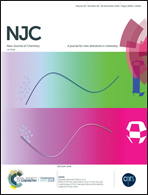An amorphous FeNiOx thin film obtained by anodic electrodeposition as an electrocatalyst toward the oxygen evolution reaction†
Abstract
The oxygen evolution reaction (OER) plays a critical part in natural and artificial water splitting reactions and also facilitates realization of the sunlight-to-fuel light-harvesting process. Because this procedure is regarded as a hindrance of electron transfer, finding robust and low-cost OER catalysts to fulfill the requirements of increasing the rate of the reaction is favored. In this work, we first developed the anodic cyclic voltammetry (CV) electrodeposition method and obtained amorphous iron nickel oxide thin films (FeNiOx); we then performed a systematic study of the electrochemical conditions and the optimization results. The crystallinity and morphology of the thin film with superior electrochemical performance were characterized by X-ray diffraction (XRD) analysis and scanning electron microscopy (SEM). In addition, investigation of the electrochemical OER performance suggested that FeNiOx has the highest activity among these samples. A small onset overpotential of 300 mV was achieved, and the Tafel slope was as low as 38 mV dec−1. The significance of this study is the systematic investigation of the catalytic composition, the simple deposition conditions, the facile and fast anodic CV electrodeposition method, and the remarkable performance and stability of the catalyst in alkaline media.



 Please wait while we load your content...
Please wait while we load your content...